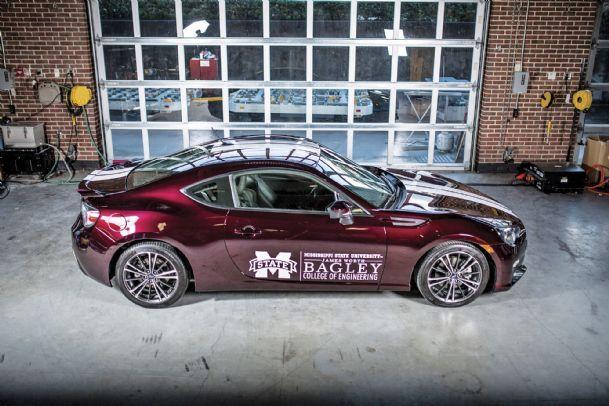Researchers from Mississippi State University’s Center for Advanced Vehicular Systems (CAVS) showcased their “car of the future” at the Society of Automotive Engineers World Congress last week in Detroit, Michigan.
This two-day event is held to bring together the newest, most cutting-edge technology in the automotive industry today, and MSU’s lighter, greener hybrid vehicle, which can travel over 100 miles on a single gallon of gas, lives up to that standard.
Matthew Doude, business development officer and research assistant at CAVS, said the reaction to the ‘car of the future’ was phenomenal.
“Everyone was, I think, universally impressed with what Mississippi State did,” Doude said. “We were definitely one of the stars of the show, and we were there beside Ford and Toyota, but I think we had as much, if not more, traffic than anyone there.”
Michelle Price, an engineering student who worked on the project, said that she is grateful to contribute to this project that is helping put MSU on the map in terms of research capabilities in the automotive engineering world.
“We had many comments at the show in Detroit about not knowing Mississippi was capable of what we accomplished,” Price said. “This project along with our Ecocar team has definitely gained us some recognition and will continue to do so, especially in the hybrid technology realm.”
The car was engineered and designed by a team of MSU faculty, students and alumni working to lead the way in energy independence.
It features control algorithms, which recognize driving patterns and can predict future ones, a custom cast magnesium sub-frame, which reduces the car’s weight by more than 40 percent, rear wheel torque vectoring, which is computer operated, creating significant performance advantages to the car’s traction, and a light-weight battery pack, which incorporates improved cell cooling through the use of proprietary cooling technologies.
Doude also said many comments were made about the car’s paint job at the show, which was done by Clinton Body Shop in Clinton, Mississippi, when their owner, John Mosley, took a personal interest in the project. The shop worked around the clock to make sure the car was ready on time for the show, painting the car in just one week they even created a special color just for the car.
“They cooked up a custom Kandy maroon color for the car, a color that they had never done before,” Doude said. “This particular method involves multiple layers of different colors, as well as several coats of show-quality clearcoat. With the Kandy maroon contrasted against the ice white pearl racing stripes, it really represents Bulldog colors well.”
The project was funded by notable alumnus and the namesake of MSU’s engineering college, James Worth “Jim” Bagley.
Doude said Bagley had a much bigger impact on the project than just providing the needed funds, and that the whole project was based on Bagley’s vision, after he presented his idea to the team over a year ago.
“He likes to tell the story about when he was young, and his dad described a vehicle that is a lot like the modern hybrid vehicles today,” Doude said. “So I think he has always wanted to fulfill his dad’s vision of this particular kind of hybrid car.”
Joseph Gaddis, research engineer at CAVS, said his favorite part of working on the ‘car of the future’ was when he began working on the project in January of 2015 as an undergraduate student, his superiors trusted his abilities and gave him and his peers freedom to design, fabricate and implement their own designs for the car.
“Being able to say that some of my designs could potentially change what people think we can do at this university is very rewarding,” Gaddis said.
Doude said that after seeing how much attention the students that worked on the project and attended the show in Detroit got from headhunters and recruiters, he and his team are looking to increase the amount of educational opportunities available for new students while creating more projects for the center.
“There’s a real need for automotive engineers, and people want to hire Mississippi State graduates,” Doude said. “I think the reason they do is because of projects like this, that give students hands-on, real-world experience of working on cars.”
Price is a prime example of how creating more projects like this will benefit engineering students for years to come.
“This project has allowed me to become familiar with what it means to be an automotive engineer,” Price said. “In the past few months, I’ve been able to add more designs and software into my portfolio, and since I ultimately want to become a design engineer, I feel like this project has given me a good taste of what that involves, and so far I’ve really enjoyed it.”
To learn more about the ‘car of the future’ project and the Center for Advanced Vehicular Systems, visit their website at cavs.msstate.edu.
Categories:
MSU Car of the Future revealed
Savannah Taggart
•
April 21, 2016
Hunter Hart | Courtesy Photo
Center for Advanced Vehicular Sytems’ “car of the future” showcased Detroit, Michigan, at the Society of Automotive Engineers World Congress.
0
Donate to The Reflector
Your donation will support the student journalists of Mississippi State University. Your contribution will allow us to purchase equipment and cover our annual website hosting costs.
More to Discover






